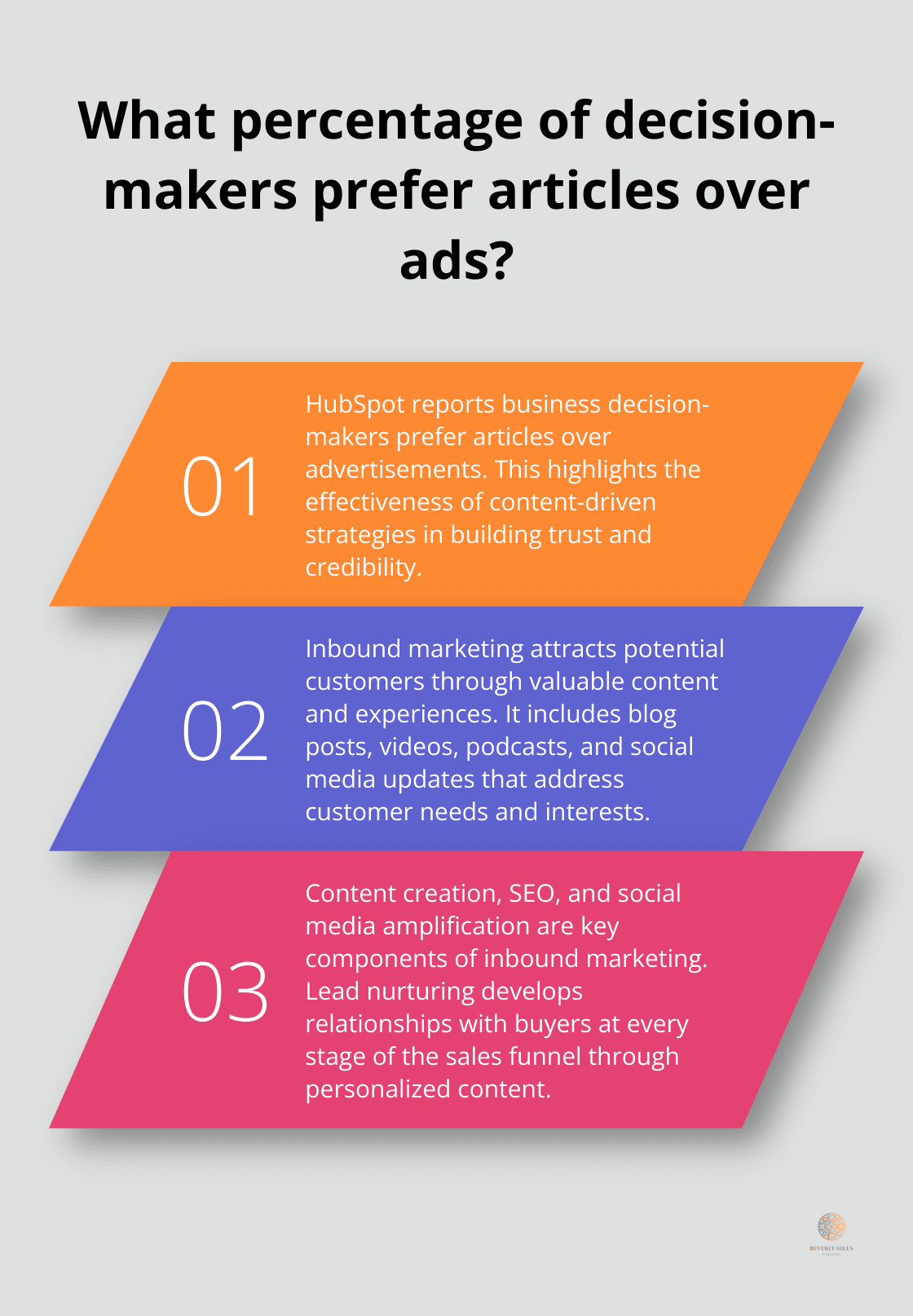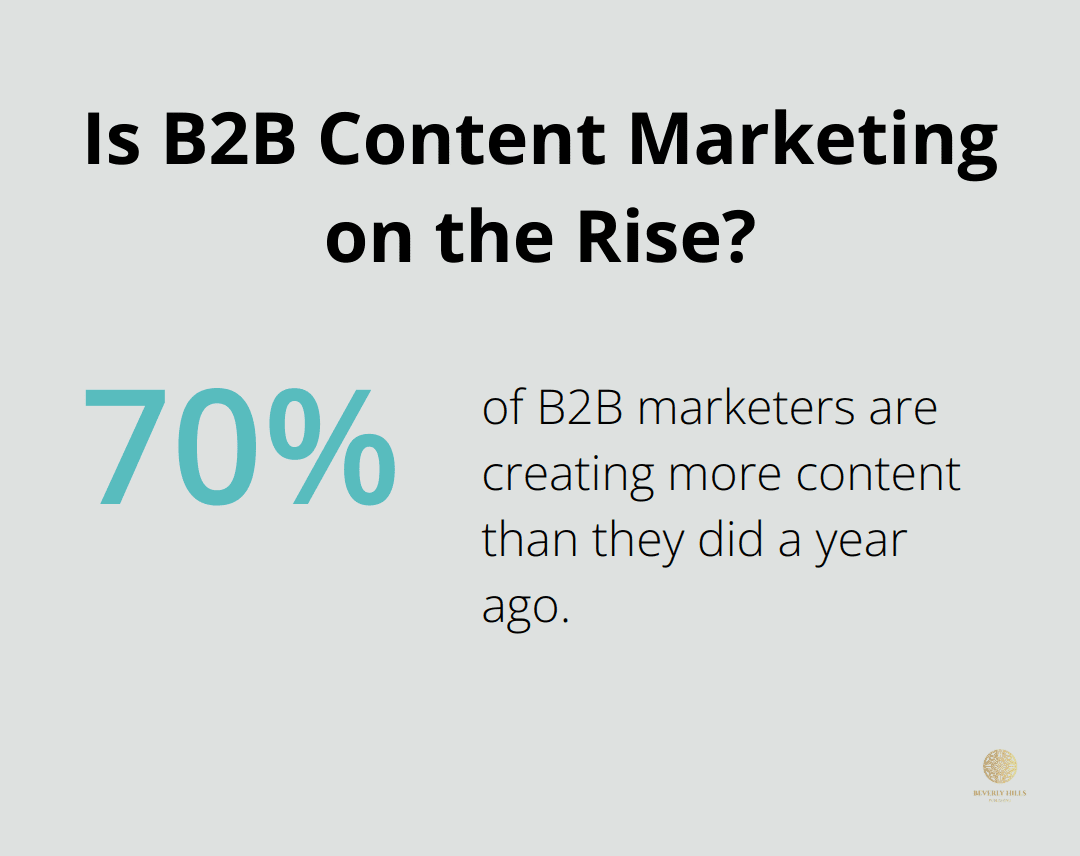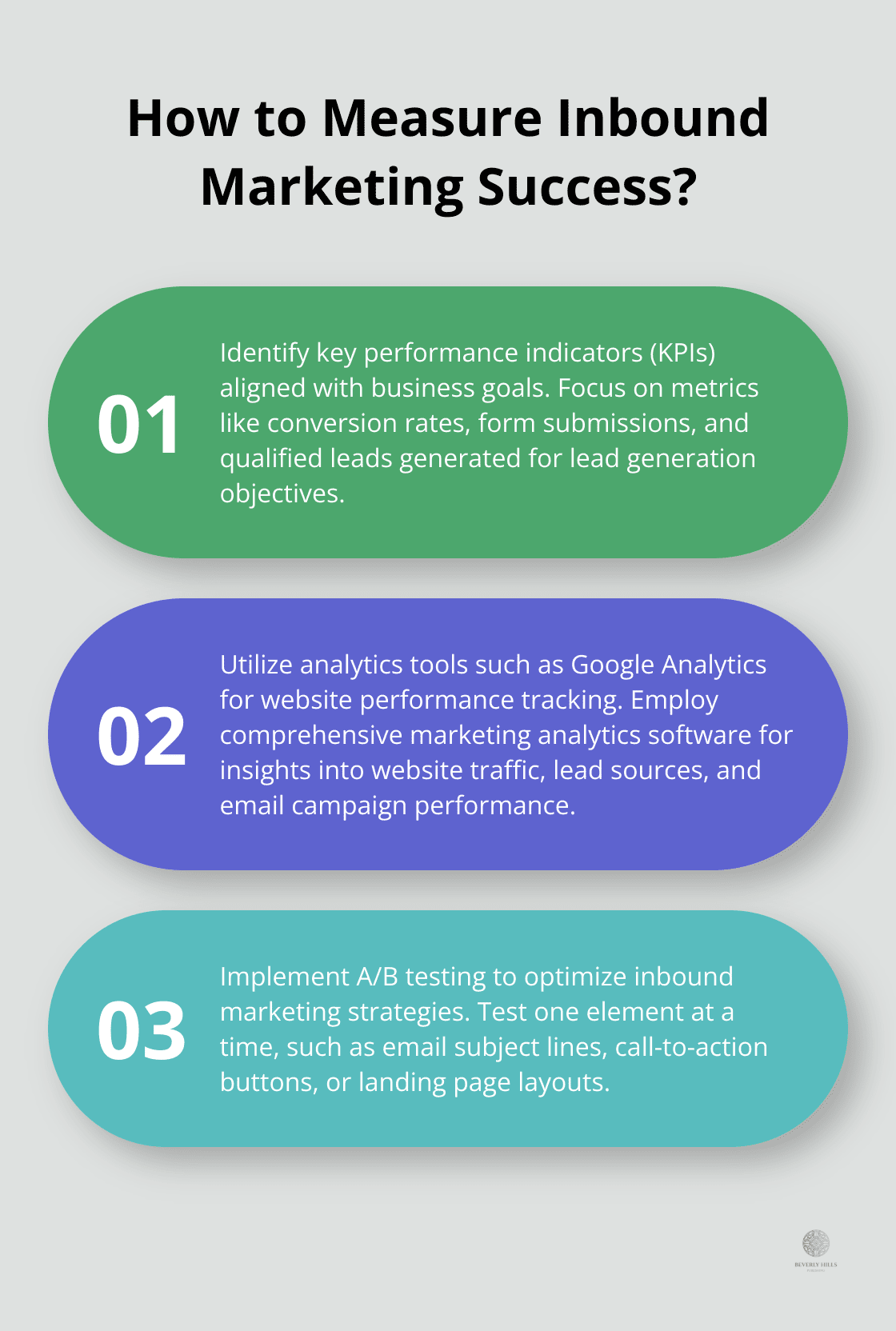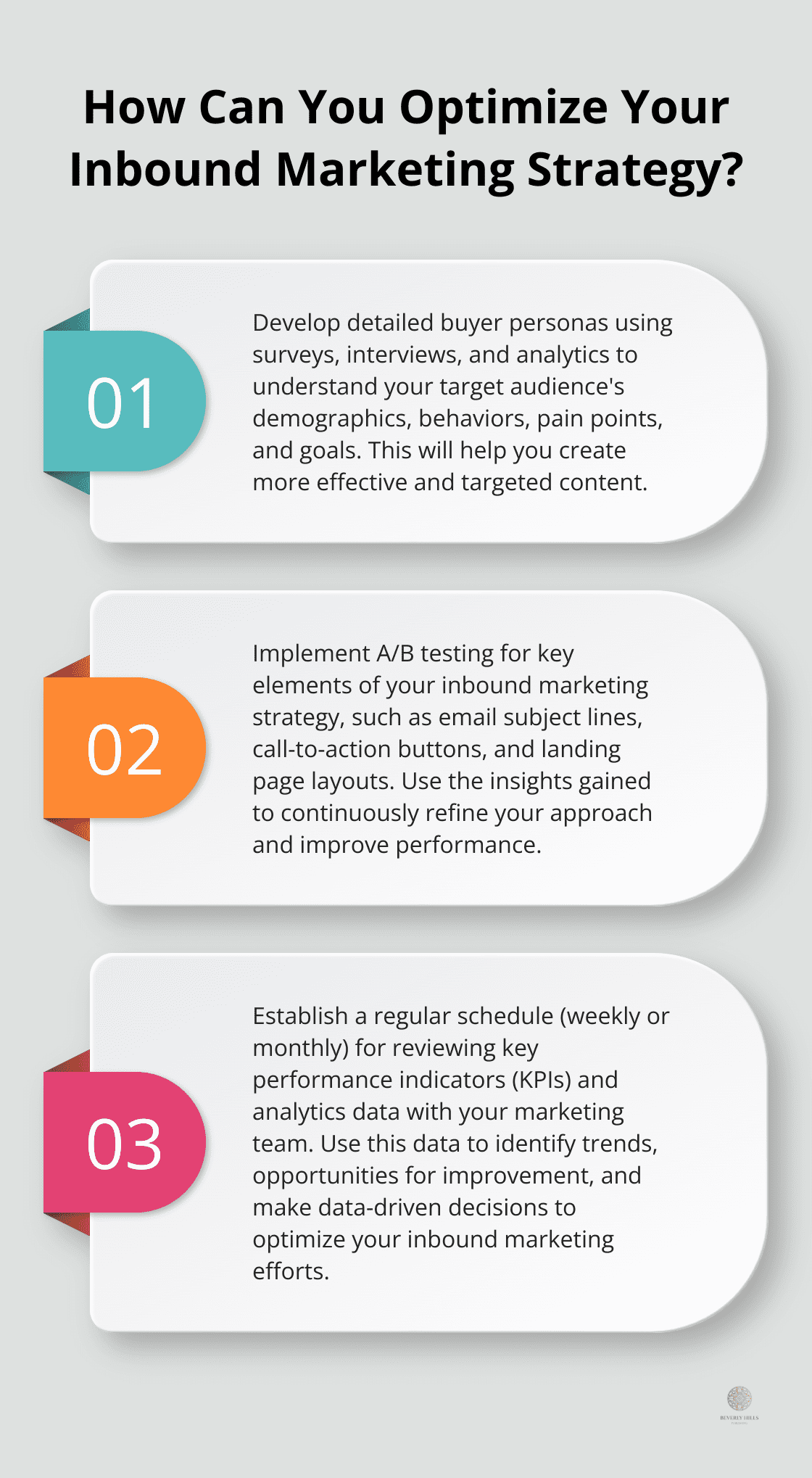Inbound marketing has revolutionized the way businesses attract and engage customers. At Beverly Hills Publishing, we’ve seen firsthand how this approach can transform marketing strategies and drive sustainable growth.
In this post, we’ll explore the essential elements of inbound marketing and provide practical tips for implementation. We’ll also recommend some top inbound marketing books to deepen your understanding of this powerful methodology.
What Is Inbound Marketing?
The Inbound Methodology Explained
Inbound marketing represents a customer-centric approach that attracts potential customers through valuable content and experiences tailored to their needs. This strategy pulls people in, rather than interrupts them with unsolicited messages.

The inbound methodology consists of three stages: attract, engage, and delight. The attract stage involves businesses creating content that addresses their target audience’s pain points and interests. During the engage stage, companies build relationships through personalized interactions and solutions. The delight stage focuses on providing exceptional customer experiences that transform customers into brand advocates.
Inbound vs. Outbound Marketing: A Clear Distinction
Inbound marketing differs significantly from traditional outbound marketing. Outbound tactics (like cold calling and TV ads) push messages to a broad audience. In contrast, inbound marketing pulls interested prospects towards your business. HubSpot reports that inbound marketing dominated organizations experience a 62% lower cost per lead than outbound marketing dominated organizations, making it a more cost-effective strategy for businesses of all sizes.
Key Components of Effective Inbound Marketing
A successful inbound marketing strategy incorporates several key components:
- Content Marketing: This forms the foundation, with businesses creating blog posts, videos, and other resources that provide value to their target audience.
- Search Engine Optimization (SEO): This plays a critical role in ensuring content is discoverable by potential customers.
- Social Media Marketing: This amplifies content reach and facilitates engagement with prospects.
- Email Marketing: This allows businesses to nurture leads and maintain relationships with existing customers.
- Marketing Automation: These tools help streamline these processes, allowing businesses to scale their inbound efforts efficiently. HubSpot indicates that marketing automation can lead to a 14.5% increase in sales productivity and a 12.2% reduction in marketing overhead.
The Power of Inbound Marketing
Inbound marketing empowers businesses to attract qualified leads, build lasting relationships, and drive sustainable growth. This approach aligns perfectly with modern consumer behavior, where people actively seek information and solutions online.
As we move forward, we’ll explore how to create valuable content that resonates with your target audience and drives your inbound marketing success.
Creating Content That Converts
The Power of Targeted Content
Content fuels your inbound marketing engine. Forty-six percent of B2B marketers think their content marketing budget will increase in 2025. However, quality trumps quantity. Effective content addresses your audience’s specific needs and pain points.

Authors who focus on their readers’ unique challenges and interests consistently produce content that engages and converts. This targeted approach transforms an author’s reach and impact.
Diversifying Your Content Portfolio
While blog posts remain essential, a diverse content mix boosts inbound marketing efforts. Video content has gained significant traction. 89% of businesses use video as a marketing tool.
Podcasts offer another powerful medium. Edison Research found that 41% of Americans listen to podcasts monthly, presenting a substantial opportunity for businesses to connect with their audience intimately.
Infographics, whitepapers, and case studies also play vital roles in a comprehensive content strategy. Each type serves a distinct purpose and appeals to different audience segments throughout their buyer’s journey.
Mastering Content Distribution
Great content creation is only half the battle. The other half involves placing that content in front of the right audience. Social media platforms excel at content distribution. LinkedIn, for instance, proves particularly effective for B2B content marketing, with 97% of B2B marketers utilizing the platform for their content efforts.
Email marketing remains a potent tool for content distribution. Campaign Monitor reports an impressive ROI of $44 for every $1 spent on email marketing. List segmentation and content personalization significantly increase engagement rates.
Optimizing for Search Engines
SEO plays a critical role in content distribution. Optimized content increases visibility and reach. Moz found that the first page of Google captures 71% of search traffic clicks, underscoring the importance of high-quality, SEO-optimized content that ranks well in search results.
Measuring Content Performance
To truly master content creation and distribution, you must measure its performance. Tools like Google Analytics provide valuable insights into content engagement, traffic sources, and conversion rates. This data allows you to refine your content marketing strategy continually.
As we move forward, we’ll explore how to leverage various digital channels to amplify your inbound marketing efforts and reach a wider audience.
Maximizing Digital Channels for Inbound Success
The Power of SEO for Visibility
Search Engine Optimization (SEO) forms the foundation of inbound marketing. It enables businesses to be discovered by the right audience at the right time. The first organic search result in Google attracts an average click-through rate of 27.6%, which highlights the importance of search engine optimization.

To enhance your SEO:
- Perform comprehensive keyword research with tools like SEMrush or Ahrefs.
- Produce high-quality, in-depth content that addresses user intent.
- Optimize your website’s technical aspects (e.g., page load speed and mobile responsiveness).
- Establish high-quality backlinks through guest posting and partnerships.
SEO requires a long-term commitment. Consistent efforts and patience will yield results over time.
Amplifying Your Message on Social Media
Social media platforms offer exceptional opportunities to boost inbound marketing efforts. These channels allow businesses to expand their reach, interact with followers, and drive website traffic. A staggering 80% of consumers expect brands to engage with them on social media (Sprout Social).
To maximize your social media impact:
- Select platforms where your target audience is most active.
- Create content tailored to each specific platform.
- Interact with your followers through comments, direct messages, and live sessions.
- Use social listening tools to track brand mentions and industry trends.
- Utilize paid social advertising to extend your reach and target specific audience segments.
Email Marketing for Lead Nurturing
Email marketing remains one of the most effective channels for lead nurturing and conversion. This strategy generates $44 for every $1 spent (Campaign Monitor), making it highly cost-effective.
To create a successful email marketing strategy:
- Segment your email list based on subscriber behavior, preferences, and demographics.
- Personalize your emails beyond using the recipient’s name (tailor content to their interests and buyer’s journey stage).
- Set up automated email sequences for lead nurturing.
- Conduct A/B tests on email subject lines, content, and call-to-actions to optimize performance.
- Track key metrics (open rates, click-through rates, and conversion rates) to refine your approach continuously.
Leveraging Content Marketing
Content marketing fuels your inbound strategy. Nearly half of the marketers say their content marketing budget will increase in 2025. Quality trumps quantity in this arena.
To optimize your content marketing:
- Focus on addressing your audience’s specific needs and pain points.
- Diversify your content portfolio (include blog posts, videos, podcasts, infographics, whitepapers, and case studies).
- Tailor your content to different stages of the buyer’s journey.
- Optimize your content for search engines to increase visibility.
- Measure and analyze your content’s performance to continually refine your strategy.
Harnessing the Power of Video Marketing
Video has become a dominant force in inbound marketing. An impressive 89% of businesses now use video as a marketing tool (Wyzowl). This medium offers a dynamic way to engage your audience and convey complex information effectively.
To leverage video marketing:
- Create diverse video content (explainer videos, product demos, testimonials, and behind-the-scenes footage).
- Optimize your videos for search engines with descriptive titles, tags, and transcripts.
- Share your videos across multiple platforms (your website, YouTube, social media).
- Use video analytics to understand viewer behavior and preferences.
- Consider live video streaming to foster real-time engagement with your audience.
Final Thoughts
Inbound marketing has transformed how businesses connect with customers. Companies create valuable content, optimize for search engines, use social media, and nurture leads through email marketing to build lasting relationships. This approach aligns with modern consumer behavior, as people actively seek information and solutions online. The long-term benefits include increased brand awareness, higher quality leads, improved customer retention, and better ROI compared to traditional outbound methods.

To implement inbound marketing, define your target audience and create detailed buyer personas. Develop a content strategy that addresses their pain points and interests across various stages of the buyer’s journey. Optimize your website, establish a strong social media presence, and set up email marketing campaigns to nurture leads and maintain customer relationships. Consider investing in marketing automation tools to streamline your efforts and scale your strategy efficiently.
For those who want to deepen their understanding of this powerful methodology, an inbound marketing book can provide valuable insights and strategies. At Beverly Hills Publishing, we help authors share their expertise and establish themselves as industry leaders through our publishing and marketing approach. Our strategy empowers authors to elevate their visibility and build strong brand identities.















































































































































































































































